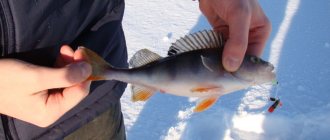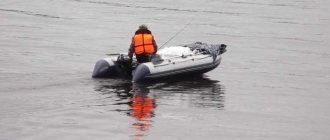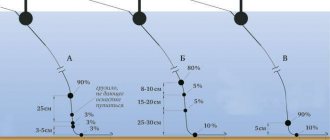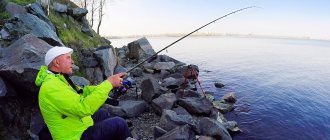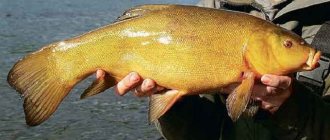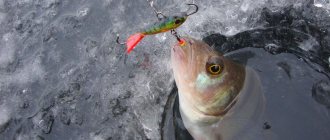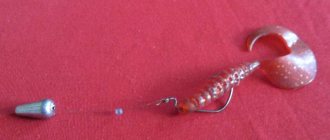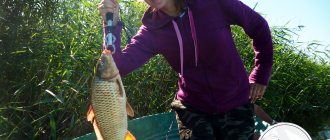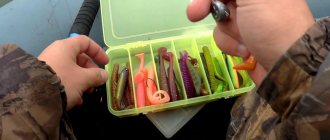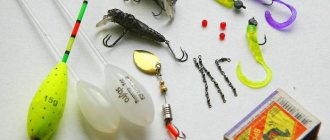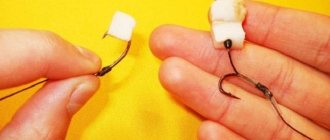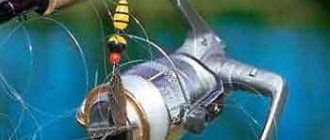Yuri 12/30/2020 614
What active and interesting debates do fishermen have about what is better in traditional fishing – bottom tackle based on a spinning rod or feeder equipment?
Recently, bottom tackle has become increasingly popular, and accordingly, new topics for debate and questions are brewing.
Let's look at the issue of fishing using the first and second methods, and which one is better - you decide for yourself.
If you dive a little into history, you can understand that initially the bottom tackle was presented in the form of a weight that was attached to the very end of the fishing line, and a little higher there were hooks. This is how they mainly caught fish that come in schools. These include, for example, roach, herring, and others. With such fishing, the fishermen could only hope that they had found a really good “fishy” place, and that the fish themselves did not mind eating. Nothing was said about bait.
In fact, now you can find a lot of debate on forums about the fact that if you attach a feeder to the donk, then it will turn out to be a feeder tackle. Some argue that this is not true, because there must be a feeder on both the donk and the feeder, otherwise you will only have to rely on luck. It turns out that this is the same thing? No. Let's figure it out.
Donka and feeder - history
Initially, the bottom tackle was a weight tightly attached to the end of the fishing line, above which leashes with hooks were tied. Currently, this option is used only in fishing to catch fish moving in schools - herring, smelt, roach, etc. There is no alarm installed here at all, and the bite is detected visually or by touch by the twitching of the fishing line. The fisherman’s main hope in this case rests on a successfully found place and the desire of the fish to get enough. We are not talking about bait.
The above equipment found its development in carp fishing, when the sinker is also tightly attached, but is already a modern functional product. There is only one leash, with a very sharp hook on a hair rig, which hooks the fish as soon as it takes the bait and starts moving. A heavy sinker weighing at least 40 grams ensures reliable hooking.
A type of donka is “rubber band”. Here, in general, a fisherman can do without a rod, the load is very heavy, first a thin rubber is attached to it, and only then comes the main line with several leashes.
Now let’s look at how a feeder differs from a donkey for each element of the tackle.
Donka
Donka
Donka is a tackle used for fishing bottom fish. The simplest design consists of a fishing line and a hook (often more than one) and sinker connected to it. The fishing rod is the most common one.
There are quite a lot of nuances that allow us to differentiate the devices under discussion and the fishing methods associated with them.
Let's start with the principle by which fishing occurs in each case. Thus, feeder fishing is based on the constant portion supply of bait into the same area of the reservoir, creating a so-called bait spot.
To do this, it is necessary to frequently throw the feeder with the mixture of the desired consistency it contains into the chosen place.
After casting, the bait is washed out of the holes and spreads along the bottom, which contributes to the accumulation of fish in this area. This is where you should then cast your fishing rod.
When fishing with a donk, a feeder can also be used, which increases the chances of a good bite. However, the bait in this case is made thicker.
The fish sucks out the food, and at the same time there is a chance that it will get hooked. Nevertheless, the difference between a feeder and a donkey is that when fishing with the latter method, it is more difficult to achieve the accumulation and retention of a large number of individuals in one place.
If, using a donkey, you use feeder feeding tactics, then there will be no sense in it. The fact is that a heavy, stiff rod is not suitable for constant recasting. It will get boring quickly.
The feeder provides easy and accurate casting due to its flexibility. In general, a rod of this type is designed in a special way.
It is equipped with a reel and has many through rings
But its main characteristic is its thin, sensitive tip, which signals any bite, even a very careful one.
In a donk, a bell is usually used for this purpose, fixed on the rod itself or on the fishing line.
In a certain sense, this should be recognized as an advantage of the bait, because you can be distracted from it if necessary (for example, to switch to another tackle) - the bell will indicate that a fish has been caught.
But due to the fact that the bell also sounds from the wind, there is a risk of missing some bites. The feeder wins in case of wind.
It should be noted that the feeder is distinguished by delicate equipment with thinner leader material, which is why the fish are less afraid.
Of course, there are exceptions, for example hunting for large carp, but this is a separate case. And so, despite the “cobwebs”, you can catch very large specimens with a feeder.
An important feature of modern equipment is the use of a single hook. A larger number of them is not required in the case of a feeder and will only create additional difficulties (for example, when fishing)
More than one hook can be attached to the bottom
A larger number of them is not required in the case of a feeder and will only create additional difficulties (for example, when fishing). More than one hook can be attached to the bottom.
If we talk about such an important point as hooking, then when fishing with a feeder, the responsibility for it lies with the fisherman. However, for many avid anglers, this is precisely what makes them most enjoyable.
The feeder allows you to feel the entire bite from the beginning until the moment of hooking. The resistance and jerks of the fish will be transmitted directly to the hand.
But if in this matter the result is more important, and not the process itself, then the usual donka should be considered more convenient.
It is easier to fish in the sense that the prey, as a rule, is hooked on its own. This is largely facilitated by a weighty sinker.
There are at least two more important points by which the considered methods of organizing fishing can be compared. What is the difference between a feeder and a donkey?
The fact is that the feeder has much greater capabilities in terms of long-distance casting
This is extremely important when, say, you need to reach a riverbed hole without a boat
It is known that sometimes a few meters decide the entire fishing result. At the same time, do not forget about the correct casting technique. For example, a spinning rod is not applicable for a feeder.
And one more significant nuance - if the reservoir is unfamiliar, then you can get used to the feeder in the best possible way. A sensitive rod will allow you to “probe” the point to find a promising place.
Fishing
All bottom irregularities will be transmitted through the feeder, and the flexible tip of the equipment will indicate the moments when the load touches the underwater surface.
In turn, bottom fishing “at random” is rarely effective. In this case, it is better to know the place well so that fishing does not remain just a contemplative activity.
Rod
For donkeys, special requirements are placed on rods for carp fishing only - they must be capable of catching 10-kilogram or more trophies. For simple rigs, any spinning rod will do. Even lightweight (“light”) forms can be adapted for catching crucian carp or bream by placing a weight of up to 20 grams or a particularly light weight plastic feeder.
For feeder fishing you need a high-tech fishing rod that has two properties:
- strength sufficient to fish out large fish weighing up to 5 kg;
- ease, so that the angler does not get tired from many casts.
In addition, such forms are necessarily equipped with a removable upper bend - the tip, which performs the unique function of a bite alarm.
The feeder rod is usually of the plug type and has a replaceable tip - an alarm
High demands on a feeder rod lead to high prices for quality products. But a lightweight and at the same time powerful blank can bring maximum comfort to the angler.
What is the difference between a spinning rod and a feeder rod?
Feeder and spinning rods are designed for catching fish; they have the same purpose. But, there are significant differences in the methodology and area of their use. Feeder rods and spinning rods are designed for completely different types of fishing. Feeder, after casting you can put it on the stand and wait for a bite. The spinning rod must be held in your hands at all times.
A feeder rod is much heavier and longer than a spinning rod. In addition, fishing with a spinning rod is much more active than when using a feeder. You can change the tips on the feeder, which indicate flexibility and the degree of bite; the spinning rod has no removable parts. What type of gear to choose is a purely individual question, which depends on preferences, type of fish, type of water body and financial capabilities.
Coil
There are no big differences here, but there are nuances. Thus, bottom fishing does not require frequent casting, so a reel is used both inertial and non-inertial. The first is rarely used in modern conditions, since it requires serious skill in preventing “beards” from the fishing line.
How to make a donka for carp with your own hands
The inertia-free one is selected based on the weight of the load being thrown. Special requirements are imposed only on those used for carp fishing - they must reel in quickly and have a powerful mechanism capable of withstanding heavy loads when fishing.
Feeders are equipped only with spinning reels, since long, frequent and accurate casts are needed. Fishing practice has developed the following criteria for choosing this element of gear:
- gear ratio in the region of 5-5.2;
- spool size – up to 4500;
- number of bearings – 5 will be enough;
- The location of the brake depends on the angler’s preferences.
The feeder reel needs to be more functional due to the many casts to come
Feeder fishing, in addition, assumes that you will have to make a lot of casts and reels of heavy equipment, so the reel mechanism must be reliable.
What is a feeder rod?
A type and optimized bottom tackle is considered to be a feeder rod. The main features of the feeder are the presence of a sensitive tip, which instantly reacts to a bite. There is a feeder classification:
- Easy class.
- Middle class. The most popular one is used by professional fishermen and is suitable for beginners.
- Hard class.
- Ultralight class (picker).
- Super heavy class (for fishing in difficult conditions).
Like a spinning rod, a feeder rod is characterized by test indicators . You should not deviate from the test parameters when choosing a form. It is better not to reach the maximum indicator with a margin of 10 g. The feeder rod visually consists of three or four components, and can reach up to 4 meters in length. The tip is always marked with a bright color to attract fish and increase the bite. The length is chosen depending on the place of fishing. The longest ones are designed for fishing in reservoirs or deep and large lakes. For shallow rivers, three-meter feeders are suitable.
Bite alarm
What's the difference here? As alarms, both simple devices are used, such as bells, bells, clips on the fishing line, which visually and ringingly indicate that the fish has taken the bait, as well as electronic devices that give an audible signal about a bite. In order for the alert to work as efficiently as possible, the rod is placed perpendicular to the water's edge towards the feeding table.
The signaling device for donkey can also be pendulum - any that is not suitable for frequent casting
As already mentioned, only a flexible removable tip signals a bite on the feeder rod. They are available in varying degrees of hardness, and each has its own color. Included with one form can be 2-3 spare elbows of this kind; the connection to the main form is plug-in.
The feeder, unlike the donkey, cannot be left unattended, since the flexible tip must always be kept in sight, and distraction threatens to lose the bait without catching fish.
The feeder uses a flexible tip that acts as a bite alarm
The rod, unlike the donkey, is located almost parallel to the coastline, then the flexible signaling whip will accurately indicate the moment of the bite.
Bite alarm
It is believed that the quiver tip is a bite indicator for the feeder. Rather, it serves as the main signaling device. Bells and swingers of all possible designs have long been used as additional ones. In bottom fishing, a bell or bell is the main signaling device. Undoubtedly, it will register the very fact of a bite better than any quivertype, it works great in the dark, and does not require you to constantly look at it to understand that the fish has bitten. However, the bell will not show how the fish behaves, how it pulls, whether it leads or not, how it swallows the bait. Here the quivertype will be beyond competition.
Feeder
Feeders for donks are not required, but if used, they are most often in the form of a spring sliding along a fishing line with a weight on the axis. The bait is stuffed into coils, a leash with a hook is knitted below or on both sides of the feeder.
Bottom tackle option with a spiral weighted feeder and two hooks
If a simple load is used, then the fisherman needs to feed the selected place. The accuracy here is low and this is the main disadvantage of this method of fishing. But if there is a shortage of bait, this property can turn into an advantage.
For the feeder, container-type feeders are needed so that when the equipment is pulled up, the bait leaves them freely. It is because of this feeder that the tackle got its name (in English “to feed” - feed).
Feeder is not a donkey for you!
In this article I will try to explain the difference between a feeder and a donkey, using the example of a situation that took place during a recent fishing trip.
I came to the Novoladozhsky Canal to fish on the feeder. I did everything according to science - mixed the bait, punched the bottom with a marker weight and found a promising area.
I carry out the starting feeding, the feeders fly to the point one after another in an endless stream. The interval between casts is 20 seconds. And a minute later the first roaches appear on the shore. Fishing at a pace is very interesting and exciting.
But not everyone had it as smoothly as I did. During the time it took me to do the above actions, my neighbors on the shore did not transfer their gear even once. And, therefore, nothing was caught. On the contrary, I was even a little tired. Because for two hours I continuously cast, hooked, pulled out fish, and fought with bleak.
After some time, a neighbor comes up to me with his feeder and asks, “What’s wrong? I also bought a feeder rod and feeders. Why do you get the bite, but I don’t?”
We talked a little, looked at his gear and it turned out that he was fishing not with a feeder, but with an ordinary donka. At home, cooked, overcooked porridge does not wash out from the feeder, and therefore does not attract fish, casting once every half hour also does not bode well, the hook is large and unbent and does not detect fish. But at the end of the fishing trip he received a bonus for his efforts; a pike landed on this hefty hook.
So what is the difference between a feeder and a donkey?
This is not just a rod with a reel and a feeder, this is no longer an object, it is a lifestyle for many anglers.
Previously, we came to the pond with a bunch of donkeys, which were equipped with metal bends for leashes, finger-thick hooks, lead weights cast in a spoon and, of course, with an integral attribute of every self-respecting donoknik - ringing bells. Next, we threw all this stuff into different directions of the reservoir and patiently waited for a bite. Some caught a lot, some caught little, some didn’t catch at all. And little depended on the professionalism of the fisherman. This is where luck came into play.
Homemade sinkers for donkey
Now we are gradually switching to thin English tackle with the name - feeder. Feeder fishing is already tactical fishing. The fisherman no longer needs to cast just anywhere, but to accurately assess the structure and topography of the bottom. Find edges, transitions from a soft bottom to a stone or shell, and other anomalies on the bottom.
After the angler finds what he thinks is a promising point, the next task will be to feed it, and not the entire water area of the reservoir. Everyone probably knows how to record the fishing distance.
Next, experiments begin with the bait mixture. You can choose a thousand options:
- Inert
- Not inert
- With a lifting effect
- With the addition of a large fraction in the form of porridges and ready-made grain mixes
- With the addition of live ingredients
- With added flavors
- Changing the color of the bait
And if after all this the fisherman doesn’t start biting, he doesn’t swear, saying that there are no fish here. He continues to look for her and pick up the key to her.
If there are no bites, I usually start thinning the tackle, using a very thin leash with a very small hook. I'm experimenting with different bait combinations. If this doesn’t help, I can change the fishing distance.
All these actions make my fishing productive. This is what distinguishes a donka from a feeder.
But, let's return to the Novoladozhsky Canal. In the meantime, a friend came to visit me, I put my feeder aside. We drank coffee, talked, and set up his gear. By the way, this was his first time fishing with it. It took about 30-40 minutes. During this time I rethrew the feeder only a couple of times.
And so I start fishing again and discover that I’m not biting. It turns out that during these 40 minutes I killed the point and turned into a donkey. Only the quivertype lacks bells
Bells for donka
So for myself, I came to the conclusion that if you want to fish, you don’t need to take such long breaks. Especially when there is a current and a lot of small fish that sweep away all the bait.
But I wasn’t upset, I still had a lot of fun.
Comparison results
A feeder or donk is united by one principle - fishing is carried out from the bottom using a load. This is where the similarity ends. Then there are differences - in the rod (the feeder has a more technologically advanced one), in the reel, in the equipment, and especially in the method of signaling the bite. The bottom can be equipped with a simple guard; the feeder rod is crowned with a brightly colored flexible tip, showing the moment the fish takes the bait. As a result, a feeder is a sports tackle that allows you to increase fishing speed and catch rate, but the final choice of which is better is up to the fisherman.
Comparison
There are quite a lot of nuances that allow us to differentiate the devices under discussion and the fishing methods associated with them. Let's start with the principle by which fishing occurs in each case. Thus, feeder fishing is based on the constant portion supply of bait into the same area of the reservoir, creating a so-called bait spot. To do this, it is necessary to frequently throw the feeder with the mixture of the desired consistency it contains into the chosen place. After casting, the bait is washed out of the holes and spreads along the bottom, which contributes to the accumulation of fish in this area. This is where you should then cast your fishing rod.
When fishing with a donk, a feeder can also be used, which increases the chances of a good bite. However, the bait in this case is made thicker. The fish sucks out the food, and at the same time there is a chance that it will get hooked. Nevertheless, the difference between a feeder and a donkey is that when fishing with the latter method, it is more difficult to achieve the accumulation and retention of a large number of individuals in one place. If, using a donkey, you use feeder feeding tactics, then there will be no sense in it. The fact is that a heavy, stiff rod is not suitable for constant recasting. It will get boring quickly.
The feeder provides easy and accurate casting due to its flexibility. In general, a rod of this type is designed in a special way. It is equipped with a reel and has many through rings
But its main characteristic is its thin, sensitive tip, which signals any, even very careful, bite. In a donk, a bell is usually used for this purpose, fixed on the rod itself or on the fishing line
In a certain sense, this should be recognized as an advantage of the bait, because you can be distracted from it if necessary (for example, to switch to another tackle) - the bell will indicate that a fish has been caught. But due to the fact that the bell also sounds from the wind, there is a risk of missing some bites. The feeder wins in case of wind.
It should be noted that the feeder is distinguished by delicate equipment with thinner leader material, which is why the fish are less afraid. Of course, there are exceptions, for example hunting for large carp, but this is a separate case. And so, despite the “cobwebs”, you can catch very large specimens with a feeder
An important feature of modern equipment is the use of a single hook. A larger number of them is not required in the case of a feeder and will only create additional difficulties (for example, when fishing)
More than one hook can be attached to the bottom.
If we talk about such an important point as hooking, then when fishing with a feeder, the responsibility for it lies with the fisherman. However, for many avid anglers, this is precisely what makes them most enjoyable.
The feeder allows you to feel the entire bite from the beginning until the moment of hooking. The resistance and jerks of the fish will be transmitted directly to the hand. But if in this matter the result is more important, and not the process itself, then the usual donka should be considered more convenient. It is easier to fish in the sense that the prey, as a rule, is hooked on its own. This is largely facilitated by a weighty sinker.
There are at least two more important points by which the considered methods of organizing fishing can be compared. What is the difference between a feeder and a donkey? The fact is that the feeder has much greater capabilities in terms of long-distance casting
This is extremely important when, say, you need to reach a riverbed hole without a boat. It is known that sometimes a few meters decide the entire fishing result.
At the same time, do not forget about the correct casting technique. For example, a spinning rod is not applicable for a feeder.
And one more significant nuance - if the reservoir is unfamiliar, then you can get used to the feeder in the best possible way. A sensitive rod will allow you to “probe” the point to find a promising place. All bottom irregularities will be transmitted through the feeder, and the flexible tip of the equipment will indicate the moments when the load touches the underwater surface. In turn, bottom fishing “at random” is rarely effective. In this case, it is better to know the place well so that fishing does not remain just a contemplative activity.
Is there a significant difference between a spinning rod and a feeder?
Both the spinning rod and the feeder are designed equally for successfully catching fish, especially predatory ones. In order for it to be successful, you must have some knowledge and practical skills in this gear.
Test
When purchasing a spinning rod, you do not need to deviate from these parameters. When planning a spinning fishing trip with a feeder, you need to choose a spinning rod with a safety margin. This gear is designed for fishing from the bottom.
Build
Both spinning rods and feeder forms have their own structure. The longer the whip, the higher the action indicator. These rods are suitable for long casting on lakes.
Feeders are also distinguished by a large number of passage rings; they provide the load evenly along the entire length of the form.
Gear selection
But, if a fisherman is confident in his use of reel equipment, then, as a rule, he will be able to do without an “anti-whip” device. And with proper assembly and casting of the “helicopter”, in addition to the fact that the leash can be larger than the anti-twist , you can simply abandon this device altogether: the leash, even a very large one, will not overlap the main line. Another aspect of gear selection causes confusion among many fishermen, namely:
- blind tackle;
- sliding tackle.
Which feeder to choose?
- Bait - for primary feeding of fish, attracting them to the fishing spot. Holds a large volume of feed, has large holes for its quickest rinsing;
- Feeder for long-distance casting - similar to a badminton shuttlecock, good for casting to the right place;
- Supplementary feeding - good in still water and in currents, has different cells for slowly washing out the feed. Its task is to keep the fish in one place for a long time.
Choice of bait
The success of feeder fishing depends on well-chosen bait. The bait is based on various cereals and cakes. They also add aromas and worms. Each fisherman has his own secrets for preparing bait.
The feeder is filled at the fishing site and always with fresh food. An exception may be fishing for carp, which is called “water pig” because of its omnivorous nature. Throw a feeder with hooks attached to it to a possible location of fish. Fixed on a stand at an angle to the plane of the water. This makes it more convenient to watch the moment of the bite.
One of the disadvantages of feeder fishing is frequent baiting. This reduces the actual fishing time. To solve this problem, feed is delivered in another way (by hand, slingshot). It became possible to use a form without a feeder, with a lighter structure. This is how light-weight picker rods with large dough appeared. There was also a spinning rod here. Picker from a spinning rod has become available to many homemade fishermen.
Suitable conditions for fishing with feeder and donk
Fishing at night
Fishing with a feeder at night is quite inconvenient for several reasons:
- Basically, a tree or any other stationary object on the opposite bank serves as a guide for casting, but at night we lose the ability to navigate to the opposite bank, we have to cast by eye, and this can smear our feeding table.
- The need for constant lighting. Since our only signaling device is the quivertip, in order to notice a bite you need to constantly illuminate it with a flashlight. Budget flashlight models are not able to shine brightly all night.
On the contrary, it’s a pleasure to catch donka at night; rare recasts and the ability to identify a bite at a distance thanks to various sound alarms allow you to get some sleep and gain strength for morning fishing.
Fishing during the ban
During the ban, fishing is allowed only with one rod with one hook and only during daylight hours, we suggest you familiarize yourself with all the bans and their periods.
The time of bans practically does not affect those who like to fish on a feeder, so this is their favorite time, because there are no bottom fishers with a huge number of rods on the banks of reservoirs and rivers.
You can always purchase a convenient stand for several rods, which makes fishing much more comfortable and saves space on the shore.
The ban on using multiple rods and fishing at night imposes significant restrictions on those who like to fish with donka. It is very difficult to achieve a good catch at this time of year.
What type of fishing should I choose?
As a rule, people come to feeder fishing after having caught plenty of donk, since feeder fishing consists of several preparatory stages that require certain experience, a mistake in any of which can cost the whole fishing trip.
If you have just started mastering fishing, then you definitely need to start with the classic donkey; mastering this type of fishing is much easier.
If you go fishing mainly in the company of friends or family and your main task is simply to relax in nature, then it is also better to choose a donka. Such fishing will give you pleasure and will not be too burdensome.
If you already have even a little experience in fishing with bottom gear, then it’s time to start mastering feeder fishing. Yes, it requires more dedication, but for its work it will reward you with exciting fishing with an excellent catch.
Carp fishing: what to choose carp bait or feeder?
For example, carp fishing rods and modern feeder rods. Both classes are for bottom fishing, but there are much more differences between these types of rods than similarities. Against the backdrop of the ever-increasing popularity of fishing, the right choice of fishing rod is of great importance. Experienced fishermen have long known the criteria by which they can choose the fishing tool that is best suited for them personally. But what should those who are not so experienced in fishing and have never before chosen a fishing rod and tackle do? This article will publish the main criteria for choosing fishing rods, which will help you make the right decision and spend your money wisely.
First of all, you should decide what type of fishing is most preferable for you and what kind of fish you are going to catch. What is the difference between feeder
carp fishing rod. Yulia Chuiko Pupilclosed 5 years ago, which is better to buy a feeder or a picker? Does it make sense to buy expensive fishing rods? It is also obvious to them that a carp rod is almost the exact opposite of a feeder rod. But beginners who would like to take up fishing cannot decide for themselves which type of fishing rod to choose. The abundance of articles about this only confuse the novice fisherman, since the mustachioed beauties can be caught both on a feeder and with a carp rod. And the fishing technique, at first inexperienced glance, is largely similar. ? A carp rod is designed for use. The rod combines strength and sensitivity, making the process much easier.
Feeder.
The first picture shows a feeder tackle; a prerequisite for it is the presence of a feeder, which delivers bait to the fishing point and thereby attracts a large number of fish. Initially, the name feeder came from (English “to feed” - “to feed”), the tackle is designed for fishing from the bottom with constant feeding of the fishing spot.
We see that the hook with the supposed bait lies on the bottom, mixed with bait for fishing with feeder equipment.
The fish gradually swim up to the feeding table, crowd together in large quantities, create a stir, thereby attracting larger individuals to the feeding point, which in turn gradually displace the smaller fish. The hook with the bait, falling into the mouth of the fish, can be slowly swallowed and the fish does not feel resistance until the leash gives tension. At this moment, an automatic hooking often occurs, the fish, frightened, makes a jerk to the side and all that remains for you is to drag the prey ashore. It often happens that after landing a fish, it turns out that it is almost impossible to pull out the hook without a special tool.
For fishing with feeder equipment, special feeder rods are usually used, but this is more about convenience than functionality, since you can use any rod with a suitable length and test. A special rod brings more pleasure from fishing; it is designed in such a way that the main length of the stick is rigid, which has a positive effect on the accuracy and casting distance; accordingly, the longer the base, the more convenient and farther the cast to the fishing point is made. The sensitivity of a feeder rod lies in the tip itself, so more often there are feeder sticks with a set of interchangeable tips of different sensitivity, for a certain weight of the assembled gear, taking into account the weight of the bait stuffed into the feeder.
Donka vs feeder or who will win?
Since I use both gear, but mostly, of course, feeder, although there is only one type of gear (bottom), I decided to announce the pros and cons of these fishing rods (this is purely my opinion, not imposed on anyone).
And so - DONKA , that is, tackle without any frills, often has a telescopic body, I have never observed a length greater than 3.6 m while fishing. I have 2 donks of 2.4 and 2.7 m plug build (2-part owner). What does it give:
— budget price from 300 rub. (cheap and cheerful);
- a reel for it in a similar price range;
— if it breaks, you don’t mind throwing it out and replacing it without any problems (any market or mini-shop).
That they are catching her. Fishing practice shows that sometimes speedsters or, as I lovingly call them, “bludgeoners” (no offense to me if anything), catch feeders, well, at least it happened to me and my comrades more than once. They catch both bream and carp.
I still remember an incident last year when I and a friend were sitting on both sides of the donkers. They have donks from their heels, thrown in a heap. Me and my feeder buddy. They ended up catching only carp during the day. About 12 of them were definitely caught, ranging from a kilo to 2.5. There were a lot of gatherings. For some reason, we only had underwear and it wasn’t very large. But this is most likely characterized by the place of fishing and the choice of bait. Apparently, the carp was not bad in their place. The distance between us was no more than 25 m.
You can catch with donks and sometimes it’s not bad. BUT:
- Installation - the feeder at the bottom, as a rule, is an oval spring with 3 short leashes and large hooks (less often an anti-twist). The weight of these feeders is limited (I have not seen more than 60 grams). And during the current you have to increase the weight up to 100 grams. (I didn’t use the big ones);
— The food is stuffed into such feeders according to the principle: the longer the food stays there, the better (I myself did this before out of ignorance);
— hooks do not make it possible to attach small bait, such as bloodworms or opium, as well as to catch smaller fish for salting. I don’t think that people who buy ready-made rigs also buy hooks of different types (not a fact, of course, but that’s the mentality of donkers);
—Leashes , in most cases, are ready-made, made of wicker, and short, which narrows the search and catch of fish. But you often have to look for fish, pick up the key to the cautious and capricious bream;
- Clip . The casting distance is usually not fixed. Many people have no idea what the red flag is for (many Chinese reels have exactly that). I was like that myself. Accordingly, the principle goes like this: the further, the better. Last year, a donker came up to me and asked: how do you throw so hard that you always end up in the same place. Well, I showed him all the delights of the clip. And when you need to throw it under the bank of a small river and in order not to throw it over, what will you do? But they often throw over and leave the gear on the other side;
— The type of casting is also the same: they throw the tackle at random, but, as a rule, from the side. This is where casting accuracy suffers;
— I haven’t seen anyone use the clutch I approached the men and checked the clutch. They have it tightly wound. Last year I had a lot of good fish in one day. Kind people suggested using a friction clutch. On the next fishing trip, the catch was 9.5 kg, mostly bream. One of them was 2.8 kg;
— Bells are a bite signal Sometimes you sit next to the daughters, as if in an orchestra pit. At one time I liked the sound of bells. But taking it off and putting it on every time is not always convenient and interesting. Some people make sure that the bell does not fly off when casting, and so they pull it out with the bell, attach it with it and cast it the same way. During the day, sometimes it blows my mind. And if you also sit on a small river at night for bream, then, of course, you may not wait for the bream. And even in the silence of the night, the ringing hurts the ears.
— Hooking and Fishing. You can create a separate topic about this. The topic can be called: I laugh, I can’t! I myself was a “bludgeoner”, but I was definitely far from the majority of those who cut and pull out like that. Then they say in annoyance: Eh, I lost my temper and left. And it was good. So a rare fish lip can resist such hooking. They cut in and run back another 5 meters. The question is why? I witnessed this year: a peasant pulls a good sazan to the donk. I, based on pure motives, approach him, I want to say that there is such a thing as a friction clutch. And he throws the donk and pulls it out with his hands by the fishing line. Just like that. As they say: comments are unnecessary.
And now the FEEDER . I came to him (the feeder) only last year. The length of the feeder ranges from 2 m to 5 m. But most likely up to 4.5 m. 5 m is already a carp rod. I won’t write about the identity of this or that length of sticks; there is a lot of information about it on the Internet.
What can you catch with it? Yes, in principle, almost any available fish (from whitefish to predator). If, as a rule, you can’t cast a donkey further than 45 m, then the fishing distance on the feeder increases to 70 m. In principle, there is no particular point in going further. No, of course, you can continue to throw, but this applies more to carp fishing with carp rods up to 150 m. I personally threw meters up to 60-65 m with a 3.9 m feeder.
— price range from 1500 to...;
— the coil for it is basically the same;
- breakage or wear of both the stick itself and the tips, but depends on various conditions (the actual skill of the feeder, the brand of the rod (use of materials), the type of tip (material, weight, guide rings). Searching for replacement tips or a tulip (tip of the tip ) can be problematic. I myself faced this question. And if the knee of the rod breaks, then generally the guard.
— The installation of the feeder can be different: paternoster, Gardner loop, symmetrical and asymmetrical loops, inline, etc. Accordingly, feeders can be mounted in different shapes and weights, which makes fishing easier in different bodies of water;
— Depending on the fishing conditions, the food
